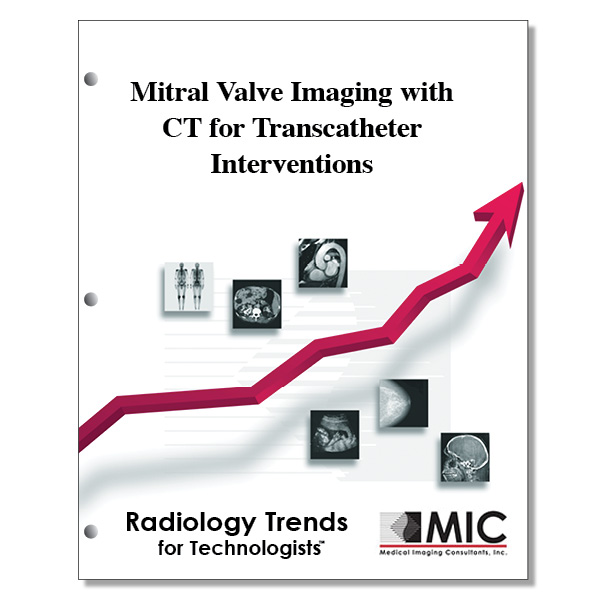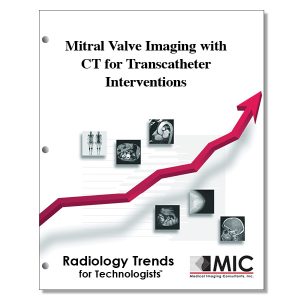

Mitral Valve Imaging with CT for Transcatheter Interventions
The role of echocardiography and multidetector CT in the diagnosis of mitral regurgitation is presented.
Course ID: Q00564 Category: Radiology Trends for Technologists Modalities: Cardiac Interventional, CT, Sonography2.5 |
Satisfaction Guarantee |
$29.00
- Targeted CE
- Outline
- Objectives
Targeted CE per ARRT’s Discipline, Category, and Subcategory classification for enrollments starting after December 10, 2024:
[Note: Discipline-specific Targeted CE credits may be less than the total Category A credits approved for this course.]
Cardiac-Interventional Radiography: 1.50
Procedures: 1.50
Interventional Procedures: 1.50
Computed Tomography: 1.75
Image Production: 0.25
Image Formation: 0.25
Procedures: 1.50
Neck and Chest: 1.50
Registered Radiologist Assistant: 1.50
Procedures: 1.50
Thoracic Section: 1.50
Outline
- Introduction
- Essential Anatomy of the Mitral Valve
- Annulus
- Leaflets
- Subvalvular Apparatus
- State of Technology in TMV Intervention
- Imaging Assessment of the Mitral Valve
- Quantification of Mitral Regurgitation
- Mechanism of Mitral Regurgitation
- Annular Sizing
- Landing Zone Characterization
- LVOT Obstruction Assessment
- Predicting Fluoroscopic Angulations
- Apex Localization and Septal Puncture
- Additional Information
- Conclusion
Objectives
Upon completion of this course, students will:
- identify the percentage of the population, over 75 years of age, who are affected by mitral valve disease
- categorize the causes of mitral regurgitation
- identify the most common cause of mitral valve stenosis
- describe the position of the mitral valve
- identify the components of the mitral valve apparatus
- describe the trigones of the annulus
- discuss the importance of identifying the aortomitral continuity
- describe the shape of the leaflets of the mitral valves
- discuss CT techniques to enhance the visualization of the scallops of the mitral valve leaflets
- describe the implications to the patient’s heart function from loss of the papillary chordal complex
- identify the transcatheter techniques to repair the mitral valve
- recognize the benefits of mitral valve repair
- identify the modalities used in imaging mitral valve regurgitation
- describe the limitation of 2D echocardiography in the quantification of the effective regurgitant orifice area
- identify MRI sequences and their use in mitral valve regurgitation quantification
- identify MRI quantification methods to calculate mitral regurgitation
- identify how mitral regurgitation is calculated on CT
- discuss the uses of 3D echocardiography in the visualization of the mechanism of mitral valve regurgitation
- identify the structure which should trigger the CT contrast enhanced acquisition of the heart for mitral valve annulus assessment
- determine the anatomy which should be used in post-processing of the mitral valve annulus
- identify the required measurements of the mitral valve annulus
- describe how primary mitral valve disease changes the shape of the annulus
- discuss the requirements of transcatheter devices used to treat mitral valve stenosis
- identify the factors which can cause LVOT obstruction after TMVR
- identify the anatomy of the neo-LVOT
- identify patients who are at risk of LVOT obstruction
- discuss the cardiac imaging phase in which neo-LVOT calculations should be performed to give the most conservative data
- identify the lines used to determine the optimal fluoroscopic angles for the coaxial deployment of the TMVR device
- describe the use of hybrid imaging during TMVR procedures
- identify the optimum approach to the mitral annulus for TMV procedures
- discuss how CT can be used to determine the proper access point for TMV procedures
- identify patients who are candidates for mitral valve surgical repair
- identify the puncture site for TMV repair
- identify essential quantitative elements which must be included in a preprocedural CT report for evaluation of mitral valve disease
- identify pathologies which can pose challenges to TMV procedures
